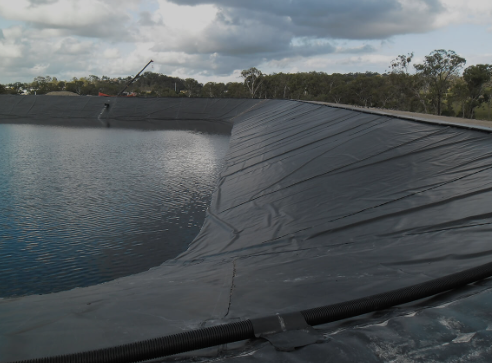- Understanding the Role of Geomembrane Liners in Waste Management
- Innovations in Geomembrane Liners for Water Management
- Geomembrane Liners: A Comprehensive Guide
- The Future of Geomembrane Liners in Civil Engineering
- Geomembrane Liners: Enhancing Landfill Stability
Manager:Alvin Wang
WhatsApp:+62 8983806051
Tel:+86 10-5797-1075
Email:steelwang@okorder.com
Address:3rd Floor, No.2 Building, No.1 Sanlihe Road
Is HDPE geomembrane harmful to humans?
hdpe Geomembranes based on High-Density Polyethylene are commonly used in civil, geo-technical and environmental applications for fluid barrier containment and environmental protection. However, while they are durable, resistant to chemicals and impermeable, concerns may be raised regarding their impact on human health. This article delves into the safety aspects of HDPE geomembranes, addressing common misconceptions and answering frequently asked questions about them being dangerous to humans.

Composition of HDPE Geomembrane
Chemical Composition:
HDPE geomemranes consist of high-density polyethylene a thermoplastic polymer produced from ethylene monomer units. HDPE is stable inert non-reactive material suitable for use where chemical resistance along with environmental compatibility is required. Generally, these geomembranes contain additional substances like UV stabilizer or Antioxidant as well as Carbon Black as additives to enhance performance and lifespan.
Physical Properties:
Among these physical properties include but not limited to flexibility, tensile strength elongation at break and puncture resistance associated with HDPE geomembranes which make it possible for them to provide containment fluid barrier or environment protection requirements under various engineering construction projects. Different thicknesses textures configurations of the sheets are designed for different specific project demands and performance criteria.
Safety Considerations
Chemical Leaching:
One concern about HDPE geomembanes is their potentiality to leach chemicals into adjacent environments especially when they come into contact with water or soil in some applications. While HDPE is regarded as chemically inert and most chemicals cannot corrode it there might be minute levels of additive or basic polymer components that still migrate out slowly through its film. However extensive research works coupled with field observations has revealed that this minor leaching of chemical substances from the membranes made from high density polyethylene (HDPE) is insignificant posing no threat whatsoever to both human beings and the environment.
Biological Degradation:
Another concern stems from the possibility of biological degradation of HDPE geomembranes. Examples include landfill liners, wastewater treatment facilities among others where microbial activities happen. Nevertheless, even though HDPE is resistant to attack by bacteria, algae and fungi might still colonize the surface of a liner leading to fouling or biofilm formation. Still, proper design installation and maintenance practices can minimize this risk as well as guarantee that HDPE geomembranes will perform for a long period of time.
Exposure Risks
Direct Contact:
In most engineering and construction applications involving HDPE geomembranes, human contact is very limited since they are usually buried or encapsulated in containment structures such as ponds, landfills and reservoirs. Consequently, chances of getting into direct contact with HDPE geomembrane are lower in these scenarios. However possible risks exist in case people come into direct contact with exposed surfaces of such geomembranes during say repair or installation procedures hence reducing potential hazards calls for wearing appropriate personal protective equipment (PPE).
Inhalation Hazards:
It should be noted that under normal operating conditions HDPE geomembranes are non-toxic and produce low levels of inhalation hazards. However whenever geomembrane welding or fabrication process is taking place there may be airborne particles/fumes that can present respiratory hazards if inhaled in concentrated quantities. Geomembrane installation or fabrication requires proper ventilation respiratory protection and compliance with occupational safety guidelines to mitigate inhalation risks associated with it.
Environmental Impact
Ecotoxicity:
The HDPE geomembranes are made with the environment in mind and have little ecotoxicity or harm to animals and plants. HDPE is non-reactive, cannot rot and resistant to biological decomposition meaning that it can be used in situations where environmental conservation is of great importance. Furthermore, at the end of their useful life, HDPE geomembranes can be recycled and reused thus minimizing their effect on the environment.
Regulatory Compliance:
HDPE liners that are produced and installed according to standards for industrial use as well as existing regulations are environmentally friendly and safe for human health. The United States Environmental Protection Agency (EPA)and other regulatory agencies have set up guidelines concerning the use of geomembranes in containment applications aimed at ensuring their integrity while maintaining safety levels. Conformity with these laws and guidelines helps prevent possible dangers connected with handling HDPE geomembranes during engineering or ecological projects.

Conclusion
To sum it all up, when installed following established conventions of the industry, HDPE geomembranes do not pose a danger to persons. Although worries may stem from chemical leaching, degradation by microorganisms or even exposure risks, extensive research work has been done both in laboratories and on the ground coupled with stringent regulatory compliance measures confirming that HDPE liners used in engineering projects guarantee personal security interest effectively. Through understanding what HDPE liners are made up of, their characteristics,and what safety precautions should be taken into consideration by people dealing with them include engineers, contractors, environmentalist among others who will be aware of its suitability as a containment material which provides environment protection fluids seals without posing any risk to human beings.
-
2024-12-05Geomembrane Liners: A Comprehensive Guide






